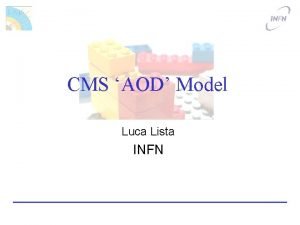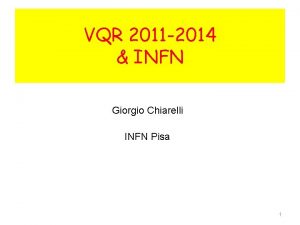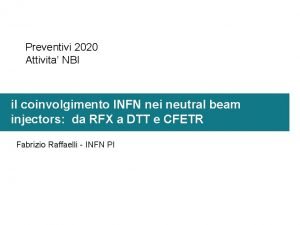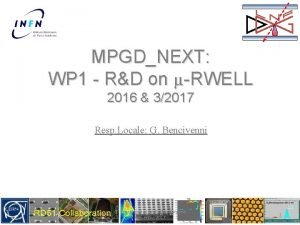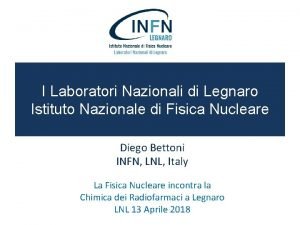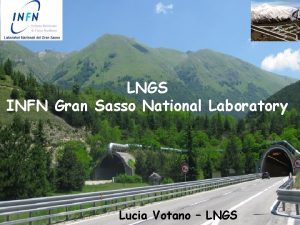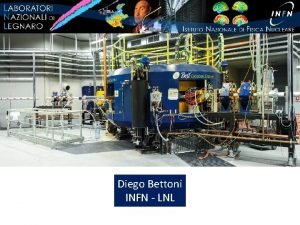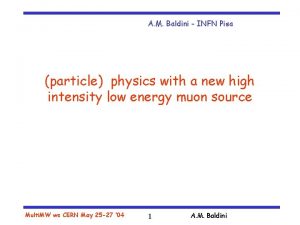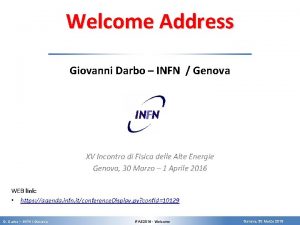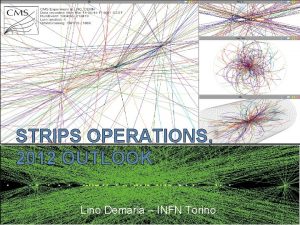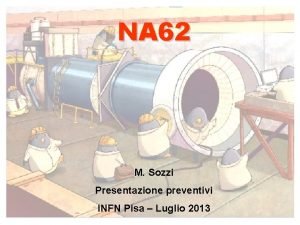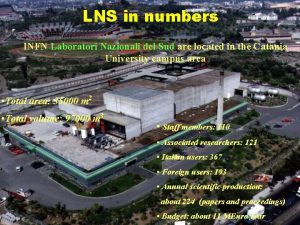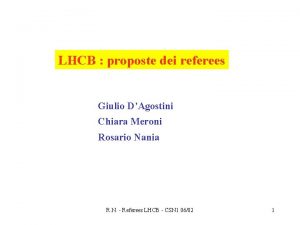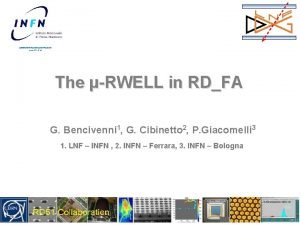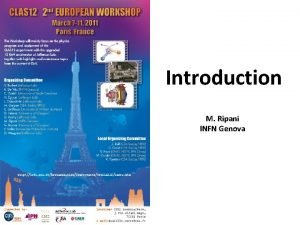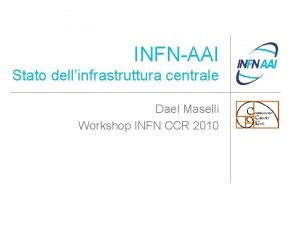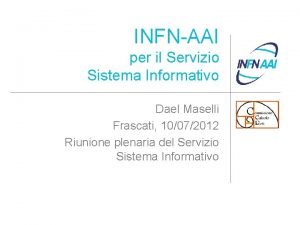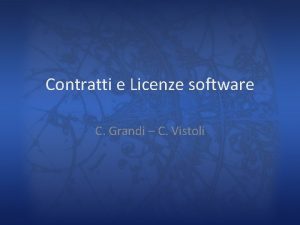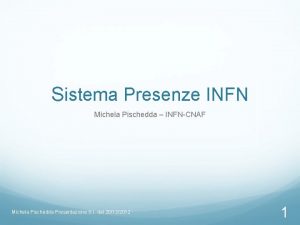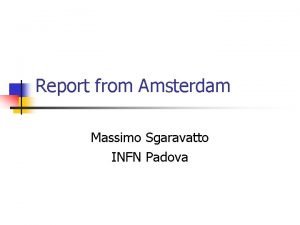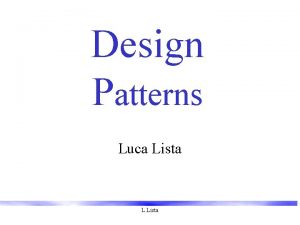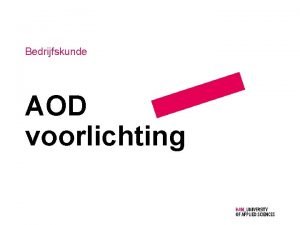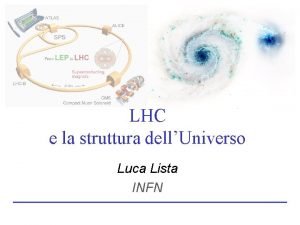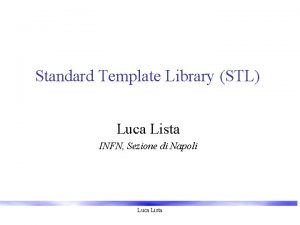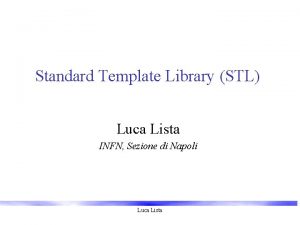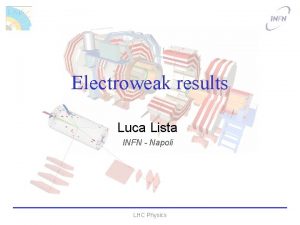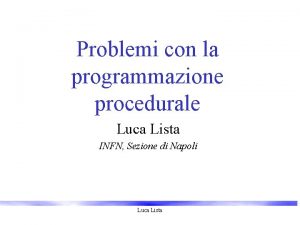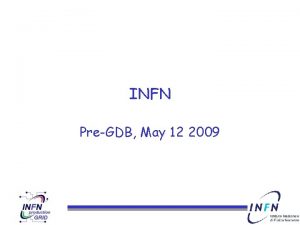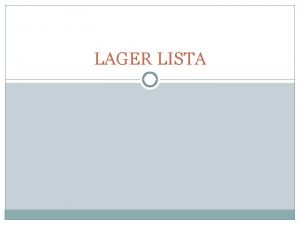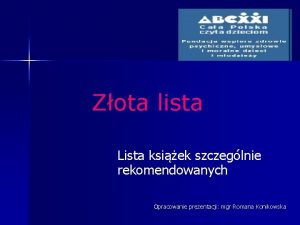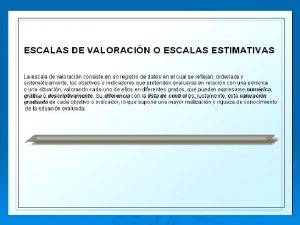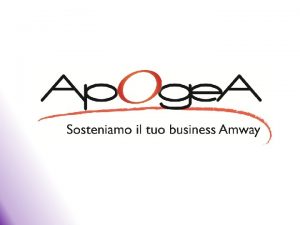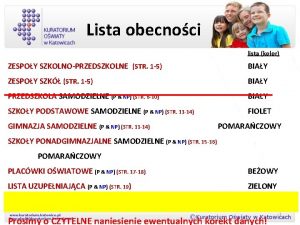CMS AOD Model Luca Lista INFN Outline CMS























- Slides: 23

CMS ‘AOD’ Model Luca Lista INFN

Outline • CMS Event Data Model • Data Tiers in CMS – FEVT, RECO, AOD, … • User data Luca Lista, INFN 2

CMS Event Data Model (EDM) • Different data access patterns: – Bare-root interactive mode: • Access object data members only – Root + data formats libraries • Interactive access full object methods • Compiled analysis code based on Root – Full Framework access • Batch processing with: – Access to external resources (DB, Geometry, …) – Interfaced to data management system Luca Lista, INFN 3

Persistency technology • Events are written using POOL with ROOT as underlying technology • Persistent class dictionaries are generated with REFLEX • Automatic loading of data formats shared library supported via SEAL plugin mechanism • Selective output of event branches is supported to allow configuring different data ‘tiers’ • Adding new data types to the Event is a simple task – The Event content is flexible and can be extended for user needs Luca Lista, INFN 4

CMS Framework Data Access • CMS Framework allows modular event processing via different module types: – Analyzer: doesn’t change the event content • E. g. : histogrammer – Producer: creates new collections and store in the event: • Each collection is stored in a separate branch in the events tree • E. g. : track producer – Filter: selects events for further processing. Adding new collections to the event is supported: • E. g: HLT filters – Event Source: provides events for subsequent processing • E. g. : Pool event source: read a POOL/ROOT file • E. g. : Event generator module – Output module: saves events to output file • can be configured to selectively write or skip root branches • POOL Output module is used as CMS default Luca Lista, INFN 5

Modular Event Products • Different data layers (‘tiers’) can be configured • The required lavels of detail can be used for different applications • Different branches are loaded (on-demand) and can be dropped if not needed Tracks. Extra Tracks. Hits t t t … T T T … h h h h h Luca Lista, INFN h h h Kinematics (helix parameters) Track extrapolation, references to Rec. Hits h h … Rec. Hits 6

ROOT Interactivity • Straightforward file access via ROOT › › g. System->Load("lib. FWCore. FWLite") Auto. Library. Loader: : enable() TFile f("reco. root") Events. Draw(“tracks. phi() - track. Extras. outer. Phi(): tracks. pt()", "tracks. pt()<10") Access without library loading (bare-root) is also possible, but limited to data member inspection Luca Lista, INFN 7

Object Cross References • Object cross-references are implemented with a CMS specific type: edm: : Ref<Collection> – No explicit ROOT dependency – Can “autoload” data if not already loaded – Contain: • A product identifier (unsigned int) • An object identifier in a collection (typically, but not necessarily, an unsigned int) – ROOT interactive use is facilitated by the index availability • also possible in ‘bare’ mode: Events. Draw(”electrons. track(). get(). pt()”); track() returns an: edm: : Ref<Track. Collection> Luca Lista, INFN get() performs dereferencing Can’t use ‘*’ with Draw(“…”) 8

Generic Containers • • • Most object collections are stored as std: : vector<T>. Polymorphic collections are stored as std: : vector<T*> – plus a policy for automatic ‘owned’ object deletion Associative maps are implemented using edm: : Ref<…>. Interactive access can be done using the indices. – Different flavors exist (one-to-one, one-to-many, etc. ) • Direct interactive access, e. g. : MC truth match map : Event. Draw( “truth. keys. pt() : truth. values. pt()” ); • Also available in bare-root mode using indices in collections: Event. Draw( “reco[ truth. map_. first ]. pt_: gen [ truth. map_. second ]. pt_” ); Explicit collection access Assuming pt_ is a data member… Luca Lista, INFN 9

Data format definition • FEVT – Full event content • RECO – Complete reconstruction output – Main client: detector studies, complex analyses • AOD (Analysis Object Data) – Subset of the RECO information – Main clients: a large fraction of analyses • The actual of the different tier is just a conventional choice Luca Lista, INFN 10

User-Defined Data • At some stage users (i. e. : Analysis Groups) can add custom quantities to the event – Straightforward in CMS EDM • User Data can be associated to objects in existing collections extending the available info • Save processing time • Store information derived from another data tier (RECO) – E. g. : energy in a specific cone • What is “User Data” and “CMS Data” can change during the experiment lifetime The EDM can replace custom tree dumps! Luca Lista, INFN 11

Particle Candidates • Establish a common “language” for analysis • Provide a common interface to many Physics tools – Constrained fits, Combiners, Jet clustering, … • Speed up the learning curve for newcomers – Learning by examples, web pages, … • It has been a successful approach in Ba. Bar – Beta toolkit Luca Lista, INFN 12

Jet from Heterogeneous Sources Muons Calo. Towers Electrons AOD Collections t t c t c t c m c m c e c e Jet. Constituents (Candidates) Contain updated kinematics info, so energy corrections can be applied j j Jets Further energy corrections can be applied Luca Lista, INFN 13

Jets from Generator Particles Gen. Particles MC truth g c g g g g g c c c c c j j g c Jet. Constituents (Candidates) Jets Luca Lista, INFN 14

H e+e- + - with Candidates Electrons Muons m m m Z Z e Ztomm (Candidates) e Z e AOD Collections Ztoee (Candidates) Analysis Collections H H Hto 4 l (Candidates) Luca Lista, INFN 15

Particle Candidates and User Data • Physics users can drop product and add new quantities to the Event at any processing stage • The output Event can be analyzed interactively with ROOT Z Z Z • The Event can be used as “n-tuple” ZCands for final analysis Es. Z , with added mu isolation Muons Mu. Isolation (User-data) i i i Luca Lista, INFN i 16

Event Skimming • Combining event selection with configurable event output allows very flexible event skimming • Skimming AOD out of RECO or FEVT can be done without running any conversion module – AOD RECO FEVT • Skimming jobs specific for analysis can write a subset of AOD (or RECO) plus quantities specific for that analysis – Collection of particle candidates, e. g. : Z l+l– Sets of variables relevant for specific studies • E. g. : lepton isolation, tagging information, … • The output of the skim is an event tree that can be used as format for final analysis – Suitable as well for further batch processing via framework! • Event skims can also be used as ‘event lists’ – Further re-skimming can be done going back to the ‘main’ data store Luca Lista, INFN 17

Foreseen Analysis Pattern At Tier 1/Tier 2 At Tier 0/ Tier 1 RECO/AOD Datasets Signal dataset AOD Preselection AOD, Cand, User Data At Tier 2 Background dataset(s) Luca Lista, INFN 18

Multiple Step Example At Tier 0/ Tier 1 RECO/AOD Datasets At Tier 1/ Tier 2 AOD Signal dataset Background dataset(s) Random guess Analysis data could use the same bookkeeping system of other data pre AOD, Cand ~500 GB At Tier 2 pre Cand, User Data Laptop ? ~50 GB Luca Lista, INFN 19

Parallel Processing • We explored TSelector as technique for parallel processing via PROOF • The main issue is to ensure that the code developed in interactive environment using TSelector is easily portable to batch processing • Solution: Customized TSelector subclass for CMS – User develop an algorithm class using the same API’s used for batch processing implementing a simple common interface – Both a CMS-TSelector and a Framework Analyzer module can be implemented from the same algorithm class • Sending shared libraries to PROOF worker nodes is under test at the moment – Trying to use the same tools used for GRID analysis job submission (CRAB) Luca Lista, INFN 20

Schema evolution – CMS release cycle is determined by data backward compatibility issues at the moment • Scheduled breaking of data backward compatibility is planned – CMS schema evolution is only relying on schema changes supported by ROOT at the moment • Can’t address all possible schema changes we have in reality – Managing within CMS software generic schema evolution will allow us to have release N+1 able to read data of release N • We need to be able to manage conversion from one data version to another with CMS-specific converters Luca Lista, INFN 21

Schema evolution (cont. ) – CMS requirements for non-trivial schema changes: • Conversion from class version N to class version N+1 should be managed within CMS code by experts of the subsystems that are not expert of ROOT core code – E. g. : no explicit management of streamers, etc. • Class names used for analysis should not be affected by version information – e. g. : always use ‘Track’ • ‘Core’ code can manage name changes – e. g. . ‘Track_001’ • A solution we would like: configure the dictionary generation to read obsolete class versions as objects with a different class name – In release N+1 read versoin N of class ‘Track’ as ‘Track_00 N’ – CMS code provide a conversion function from ‘Track_00 N’ to ‘Track’, which is used in analysis – We look forward for next ROOT team ideas on generic schema evolution to address this problem Luca Lista, INFN 22

Conclusions • CMS Event Data Model is a flexible tool for event storage in any format – RECO/AOD, but also analysis-oriented • Interactive capabilities make the EDM a suitable tool for both batch and interactive analysis via ROOT • 2007 “challenge” will exercise the EDM/AOD capabilities in concrete analysis exercises Luca Lista, INFN 23
 What is aod
What is aod What is an aod
What is an aod Luca outline
Luca outline Quotation sandwhich
Quotation sandwhich Giorgio chiarelli infn
Giorgio chiarelli infn Preventivi infn
Preventivi infn Www.lnf.infn.it
Www.lnf.infn.it Rilab data sc
Rilab data sc Infn gran sasso
Infn gran sasso Infn lnl
Infn lnl Infn pisa
Infn pisa Infn genova
Infn genova Infn lnf webmail
Infn lnf webmail Preventivi infn
Preventivi infn Lns infn
Lns infn Chiara meroni infn
Chiara meroni infn Www.lnf.infn.it
Www.lnf.infn.it Infn genova
Infn genova Infn-aai
Infn-aai Dael maselli
Dael maselli Infn roma tor vergata
Infn roma tor vergata Licenze nazionali infn
Licenze nazionali infn Missioni infn
Missioni infn Infn padova
Infn padova


